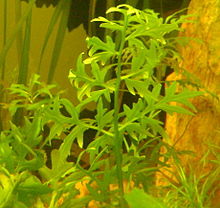
A gametophyte is one of the two alternating multicellular phases in the life cycles of plants and algae. It is a haploid multicellular organism that develops from a haploid spore that has one set of chromosomes. The gametophyte is the sexual phase in the life cycle of plants and algae. It develops sex organs that produce gametes, haploid sex cells that participate in fertilization to form a diploid zygote which has a double set of chromosomes. Cell division of the zygote results in a new diploid multicellular organism, the second stage in the life cycle known as the sporophyte. The sporophyte can produce haploid spores by meiosis that on germination produce a new generation of gametophytes.

In biology, a spore is a unit of sexual or asexual reproduction that may be adapted for dispersal and for survival, often for extended periods of time, in unfavourable conditions. Spores form part of the life cycles of many plants, algae, fungi and protozoa.

Alternation of generations is the predominant type of life cycle in plants and algae. In plants both phases are multicellular: the haploid sexual phase – the gametophyte – alternates with a diploid asexual phase – the sporophyte.

Bryophytes are a group of land plants, sometimes treated as a taxonomic division, that contains three groups of non-vascular land plants (embryophytes): the liverworts, hornworts and mosses. In the strict sense, Bryophyta consists of the mosses only. Bryophytes are characteristically limited in size and prefer moist habitats although they can survive in drier environments. The bryophytes consist of about 20,000 plant species. Bryophytes produce enclosed reproductive structures, but they do not produce flowers or seeds. They reproduce sexually by spores and asexually by fragmentation or the production of gemmae. Though bryophytes were considered a paraphyletic group in recent years, almost all of the most recent phylogenetic evidence supports the monophyly of this group, as originally classified by Wilhelm Schimper in 1879. The term bryophyte comes from Ancient Greek βρύον (brúon) 'tree moss, liverwort', and φυτόν (phutón) 'plant'.

A sporophyte is the diploid multicellular stage in the life cycle of a plant or alga which produces asexual spores. This stage alternates with a multicellular haploid gametophyte phase.

Gymnocarpium dryopteris, the western oakfern, common oak fern, oak fern, or northern oak fern, is a deciduous fern of the family Cystopteridaceae. It is widespread across much of North America and Eurasia. It has been found in Canada, the United States, Greenland, China, Japan, Korea, Russia, and most of Europe. It is a seedless, vascular plant that reproduces via spores and have a life cycle with alternating, free-living sporophyte and gametophyte phases.

Pteridaceae is a family of ferns in the order Polypodiales, including some 1150 known species in ca 45 genera, divided over five subfamilies. The family includes four groups of genera that are sometimes recognized as separate families: the adiantoid, cheilanthoid, pteridoid, and hemionitidoid ferns. Relationships among these groups remain unclear, and although some recent genetic analyses of the Pteridales suggest that neither the family Pteridaceae nor the major groups within it are all monophyletic, as yet these analyses are insufficiently comprehensive and robust to provide good support for a revision of the order at the family level.
Monoicy is a sexual system in haploid plants where both sperm and eggs are produced on the same gametophyte, in contrast with dioicy, where each gametophyte produces only sperm or eggs but never both. Both monoicous and dioicous gametophytes produce gametes in gametangia by mitosis rather than meiosis, so that sperm and eggs are genetically identical with their parent gametophyte.

A prothallus, or prothallium, is usually the gametophyte stage in the life of a fern or other pteridophyte. Occasionally the term is also used to describe the young gametophyte of a liverwort or peat moss as well. In lichens it refers to the region of the thallus that is free of algae.
Plant reproduction is the production of new offspring in plants, which can be accomplished by sexual or asexual reproduction. Sexual reproduction produces offspring by the fusion of gametes, resulting in offspring genetically different from either parent. Asexual reproduction produces new individuals without the fusion of gametes, resulting in clonal plants that are genetically identical to the parent plant and each other, unless mutations occur.

Ceratopteris thalictroides is a fern species belonging to the genus Ceratopteris, one of only two genera of the subfamily Parkerioideae of the family Pteridaceae.
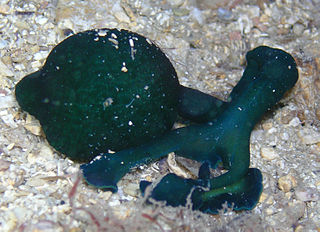
Environmental sex determination is the establishment of sex by a non-genetic cue, such as nutrient availability, experienced within a discrete period after fertilization. Environmental factors which often influence sex determination during development or sexual maturation include light intensity and photoperiod, temperature, nutrient availability, and pheromones emitted by surrounding plants or animals. This is in contrast to genotypic sex determination, which establishes sex at fertilization by genetic factors such as sex chromosomes. Under true environmental sex determination, once sex is determined, it is fixed and cannot be switched again. Environmental sex determination is different from some forms of sequential hermaphroditism in which the sex is determined flexibly after fertilization throughout the organism’s life.

Lophosoria quadripinnata(J.F.Gmel.) C.Chr. is a species of fern that, according to DNA molecular analysis, belongs to the family Dicksoniaceae, where it is placed in the genus Lophosoria. It is found in the Americas spanning from Cuba and Mexico to Chile. In Chile it is present in the area between Talca and Aysén including Juan Fernández Islands. In Argentina it grows only in the humid valleys of western Neuquén and Río Negro Province. Diamondleaf fern is a common name. In Spanish it is known as 'ampe' or palmilla, but one has to remember that there are several species of ferns called "palmillas" that have larger or smaller fronds, and which grow in colder climates. It is a medium-sized plant, growing to about 4–5 feet and even though the rhizome does not grow a trunk, it is clearly related to the other tree ferns due to features that were apparently already present in their common ancestor, like 'pneumathodes', and the rhizome which changed from the dorsiventral symmetry typical of the other ferns, to a radial symmetry typical of tree ferns. Their large and multiple pinnate fronds, with the petiole raised adaxially, and the hairs on the rhizome and lower part of the petioles, also resemble those of tree ferns. To identify the species, use the position and characteristics of the spores found on the fertile fronds. The genus already existed in the Cretaceous Period in southern Gondwana according to fossil remains found in Antarctica. The species is well known as an ornamental plant.

Sexual reproduction is a type of reproduction that involves a complex life cycle in which a gamete with a single set of chromosomes combines with another gamete to produce a zygote that develops into an organism composed of cells with two sets of chromosomes (diploid). This is typical in animals, though the number of chromosome sets and how that number changes in sexual reproduction varies, especially among plants, fungi, and other eukaryotes.
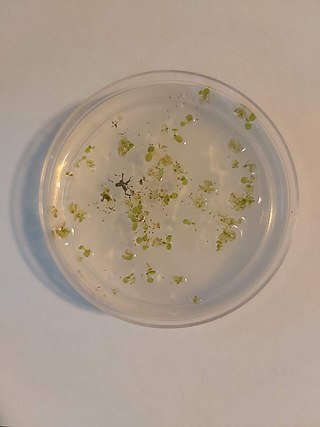
Ceratopteris richardii is a fern species belonging to the genus Ceratopteris, one of only two genera of the subfamily Parkerioideae of the family Pteridaceae. It is one of several genera of ferns adapted to an aquatic existence. C. richardii was previously regarded as being part of the species Ceratopteris thalictroides.
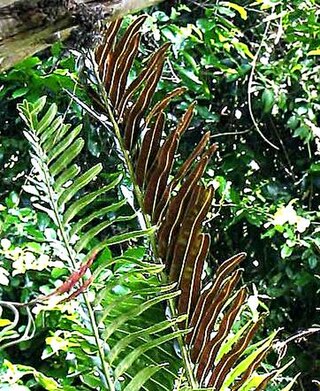
Acrostichum is a fern genus in the Parkerioideae subfamily of the Pteridaceae. It was one of the original pteridophyte genera delineated by Linnaeus. It was originally drawn very broadly, including all ferns that had sori apparently "acrostichoid", or distributed in a uniform mass across the back of the frond, rather than organized in discrete sori. This led Linnaeus to include such species as Asplenium platyneuron in the genus, because the specimen he received had sori so crowded that it appeared acrostichoid.

Hymenophyllum australe, commonly known as austral filmy fern, is a relatively large rupestral and epiphytic fern, indigenous to eastern Australia and New Zealand. It belongs to the unique Hymenophyllum genus, which are characterised by their thin membranous fronds that are seldom more than one cell thick, with the exception of regions over and around veins. Hymenophyllum australe is distinctive in that the fronds are typically thicker than other Hymenophyllum species, often being up to 2-3 cells thick.

Asterotheca is a genus of seedless, spore-bearing, vascularized ferns dating from the Carboniferous of the Paleozoic to the Triassic of the Mesozoic.
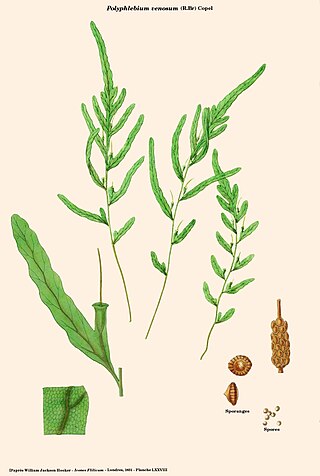
Polyphlebium venosum, the veined bristle-fern or bristle filmy fern, is a fern in the family Hymenophyllaceae. It is only found in wet forests, mainly growing as an epiphyte on the shady side of the soft tree fern, Dicksonia antartica. It also grows on logs, trunks of trees and rarely on trunks of Cyathea species or on wet rock-faces. It is found in the wetter parts of Eastern Australia and New Zealand. P. venosum has poor long-distance dispersal compared to other ferns due to its short lived spore. Notable features of Polyphlebium venosum include it being one cell layer thick, 5–15 cm in length, having many branching veins and a trumpet shaped indusium.
Antheridiogens are a class of chemicals secreted by fern gametophytes that have "been shown to influence production of male gametangia and thus mating systems in a large number of terrestrial fern species". Antheridiogens are only observed in homosporous fern species, as all gametophytes are potentially bisexual.
